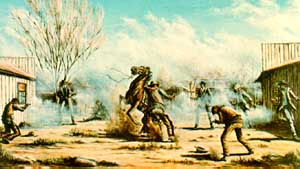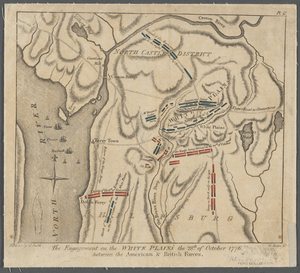October 26, 1881 The Gunfight at the O.K. Corral
On 25th October, Ike Clanton and Tom McLaury arrived in Tombstone. Later that day Doc Holliday got into a fight with Ike Clanton in the Alhambra Saloon. Holliday wanted a gunfight with Clanton, but he declined the offer and walked off.
The following day Ike Clanton and Tom McLaury were arrested by Virgil Earp and charged with carrying firearms within the city limits. After they were disarmed and released, the two men joined Billy Clanton and Frank McLaury, who had just arrived in town. The men gathered at a place called the OK Corral in Fremont Street.
Virgil Earp now decided to disarm Billy Clanton and Frank McLaury and recruited Wyatt Earp, Morgan Earp and Doc Holliday to help him in this dangerous task. Sheriff John Behan was in town and when he heard what was happening he raced to Fremont Street and urged Billy Clanton and Frank McLaury to hand over their guns to him. They replied: "Not unless you first disarm the Earps".
Behan now headed towards the advancing group of men. He pleaded for Virgil Earp not to get involved in a shoot-out but he was brushed aside as the four men carried on walking towards the OK Corral. When they reached the four men, Virgil Earp said: "I want your guns". Billy Clanton responded by firing at Wyatt Earp. He missed and Morgan Earp successfully fired two bullets at Billy Clanton and he fell back against a wall. Meanwhile Wyatt Earp fired at Frank McLaury. The bullet hit him in the stomach and he fell to the ground.
Ike Clanton and Tom McLaury were both unarmed and tried to run away. Clanton was successful but Doc Holliday shot McLaury in the back. Billy Clanton and Frank McLaury, although seriously wounded, continued to fire their guns and in the next couple of seconds Virgil Earp, Morgan Earp and Doc Holliday were all wounded. Wyatt Earp was unscathed and he managed to finish off Billy Clanton and Frank McLaury.
Sheriff John Behan arrested Virgil Earp, Wyatt Earp, Morgan Earp and Doc Holliday for the murder of Billy Clanton, Tom McLaury and Frank McLaury. However, after a 30 day trial Judge Wells Spicer, who was related to the Earps, decided that the defendants had been justified in their actions.
Over the next few months the Earp brothers struggled to retain hold control over Tombstone. Virgil Earp was seriously wounded by an assassination attempt and Morgan Earp was killed when he was playing billiards with Wyatt Earp on 18th March, 1882. Eyewitnesses claimed that Frank Stilwell was seen running from the scene of the crime. Three days later Stilwell's was found dead. A Mexican who was also implicated in the crime was also found murdered in a lumber camp. It is believed that Wyatt Earp was responsible for killing both men.

October 26, 1917 Passchendaele Offensive is begun
two divisions of the Canadian Corps were moved into the line to replace the badly depleted ANZAC forces. After their successes at Vimy Ridge and the Battle of Hill 70. Upon his arrival, the Canadian Commander-in-Chief General Sir Arthur Currie expressed the view that the cost of the objective would be sixteen thousand casualties. While Currie viewed this figure as inordinately high in relation to the value of the objective, Haig had estimated that the casualties from remaining in place would be worse if this objective was not taken.
The Canadians moved into the line during mid-October, and on 26 October 1917, the Second Battle of Passchendaele began with twenty thousand men of the Third and Fourth Canadian Divisions advancing up the hills of the salient. It cost the Allies twelve thousand casualties for a gain of a few hundred yards.
Reinforced with the addition of two British divisions, a second offensive on 30 October resulted in the capture of the town in heavy rains. For the next five days the force held the town in the face of repeated German shelling and counterattacks, and by the time a second group of reinforcements arrived on 6 November, four-fifths of the infantrymen in two Canadian divisions had been lost.
Their replacements were the First and Second Canadian Divisions. German troops still ringed the area, so a limited attack on the 6th by the remaining troops of the Third Division allowed the First Division to make major advances and gain strong points throughout the area.
One such action on the First Division front was at Hill 52; the Tenth Battalion, CEF were called out of reserve to assist an attack on Hill 52, part of the same low rise where Passchendaele was situated. The Battalion was not scheduled to attack, but the Commanding Officer of the Tenth had wisely prepared his soldiers as if they would be making the main assault – a decision that paid dividends when the unit was called out of reserve. On 10 November 1917, the Tenth Battalion took the feature with light casualties.
A further attack by the Second Division the same day pushed the Germans from the slopes to the east of the town. The high ground was now firmly under Allied control.
After all was said and done, General Currie's casualty estimations sadly proved to be remarkably accurate. The battle of Passchendaele cost the Canadian Corps 15 654 casualties with over 4 000 dead to take roughly 6.25 square kilometres of German held territory in 16 days of fighting.[1].
Canadian soldiers won a remarkable 9 Victoria Crosses in the fighting at Passchendale.
Aftermath
Passchendaele could be regarded, by some, as a re-play of the Somme; an offensive mounted by the British and French Forces designed to make large gains in terms of territory. However, given the importance of the Ypres salient — the campaign to clear the high ground east and south of the much battered city was important, but once it began, it had to be completed.
After months of fighting, the Allies had crawled forward 5 miles (8 kilometres) but had gained the high ground that dominated the salient. The price had been almost half a million men of which around 140,000 had been killed. Also reminiscent of the Somme were the colossal artillery barrages which failed to destroy German defenses, but which did inflict enormous losses that the Germans couldn't afford. Ultimately, as a battle of attrition, that captured some important assets, the campaign can be said to be a lean Allied victory.
More than any other battle, Passchendaele has come to symbolise the horrific nature of the great battles of the First World War. In terms of the dead, the Germans lost approximately 260,000 men, while the British Empire forces lost about 300,000, including approximately 36,500 Australians, 3,596 New Zealanders and some 16,000 Canadians from 1915 to 1917. 90,000 British and Dominion bodies were never identified, and 42,000 never recovered. Aerial photography showed 1,000,000 shell holes in 1 square mile (2.56 km²).




